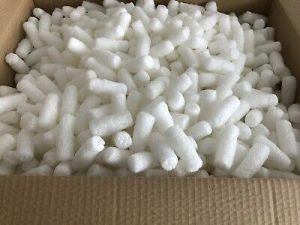Can I Compost Dissolvable Packing Peanuts?
Dear Eartha, I recently received a package with white peanuts that dissolve in water. I assume they are made of starch or at least I’ve heard of that. Can I compost them? – Diane, Frisco

Excellent question Charlotte. The first time I received a package with what appeared to be puffy cereal protecting the contents, I began investigating them myself. Turns out, it would have been perfectly fine for me to have dumped the puffy contents into a giant bowl and chowed down. In fact, these protective packaging tools are manufactured through a similar process as their tasty counterparts. Although I am not recommending you do so, feasting on these protective puffs is an option nonetheless to the most adventurous of foodies. To answer your question simply: yes, you can certainly compost these eco-friendly packing pellets. However, I’d prefer to really sink my teeth into this inquiry.
Summit County’s Resource Allocation Park (SCRAP), is comprised of our local landfill, recycling, and compost facilities. Open to the public 6 days a week, this facility perched upon the south-facing hillside west of Keystone, is responsible for handling everything from our locally generated recyclables to our municipal solid waste. Massive piles of organic matter dot the “compost pad”, a portion of land at the SCRAP dedicated to the extensive composting operation. Heavy machinery and oversized trucks turn the giant piles throughout the year to produce the dark, nutrient rich material. My first visit to the compost pad left me shocked, as I found myself overlooking one of the most beautiful vistas in Summit County.
The High Country Conservation Center runs the residential compost collection program available to county residents. This program provides the vital input resource for this process. Composting through this program is restricted to food scraps only. Meaning, we don’t accept any manufactured compostable products in this program. These manufactured compostables include your forks, knives, plates, cups, and other products traditionally advertised as compostable. For this reason, we unfortunately cannot accept these compostable packing peanuts in our compost program. Fret not, I promise you can still compost this product.
Bio-solids make up a significant portion of the input resources for our local composting operations. Much like the foods scraps collected through our compost drop off program, these bio-solids ultimately end up at the SCRAP’s compost pad. Filtered out from our household waste stream, these bio-solids provide much needed fuel to generate our local compost. Contributing to this stream of resources is easier than one might think. It occurred to me during my first visit to the pad, that the standard household garbage disposal contributes to this vital resource stream.
 With regards to your compostable packing peanuts, simply toss them in your kitchen sink and run the water until they dissolve. If you’d prefer, you can even utilize these pellets in your backyard composting operation. Comprised entirely of plant-based proteins and starch, these modern compostable peanuts are often 100% biodegradable. Most major manufacturers have these products certified under the Biodegradable Products Institute (BPI) as well as the American Society for Testing and Materials (ASTM) for their compliance with modern composting standards.
With regards to your compostable packing peanuts, simply toss them in your kitchen sink and run the water until they dissolve. If you’d prefer, you can even utilize these pellets in your backyard composting operation. Comprised entirely of plant-based proteins and starch, these modern compostable peanuts are often 100% biodegradable. Most major manufacturers have these products certified under the Biodegradable Products Institute (BPI) as well as the American Society for Testing and Materials (ASTM) for their compliance with modern composting standards.
In addition to being an eco-friendly alternative to traditional Styrofoam packing products, these compostable versions help divert waste from our landfills, creating instead a resource with practical applications. Non-biodegradable options can take hundreds or even thousands of years to break down and can even end up polluting valuable ecosystems such as our oceans. Keep an eye out for these compostable pellets and learn to identify them as you receive packages. Simply run a pellet under water to determine if its biodegradable. Compostable packaging pellets will completely dissolve in a matter of minutes. To join the food-scrap drop off program or to schedule a SCRAP tour, contact us at the High Country Conservation Center.
-
[…] to be super careful about how you dispose of them. But if you want to be neat about it, you can wash these peanuts down the sink or throw them in your backyard compost. They’re big and fluffy for the shipping […]
[…] sources, including a 2019 article from HighCountryConservation.org, say they can be used as a compost or fertilizer in your garden. Try dissolving them in a […]
[…] These products are more environmentally friendly than traditional packing peanuts as there are no harmful additives present. This is because they are compostable and biodegradable. […]
[…] Source: … […]
Leave a Comment





I like the idea of composting these peanut starch-based pellets. However, given these pellets contain starch, will the build up of starch in the compost heap not attract vermin? Rats/Mice etc?
I would suggest NOT running the water until the peanuts dissolve – that is wasting a very precious resource. How about fill a pan with water, or plug the sink with a stopper?
Just what I was searching for, appreciate it for putting up.
HighCountryConservation suggests “simply toss them in your kitchen sink and run the water until they dissolve”?? Doesn’t sound like it’s conserving anything but more like wasting water!
That’s true of a lot of composting material such as fruit rinds and vegetable scraps. I keep my compost in an above ground, sealed plastic tumbling bin for the first 1-2 months of its existence to let it decompose past the point where mammalian critters would still be interested in it, whatever it started out as. Then it goes into an open wooden bin to further decompose after that. I haven’t had any rodent issues with this method.